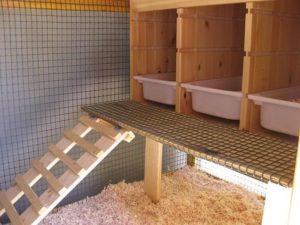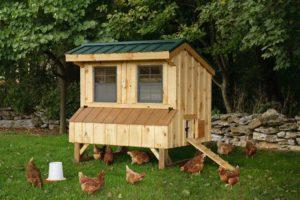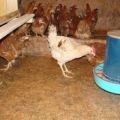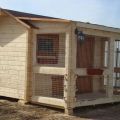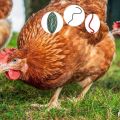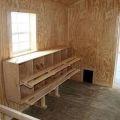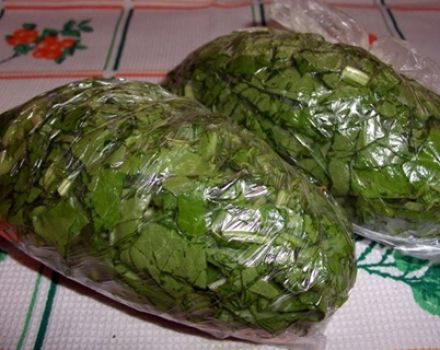Types of bedding on the floor for a chicken coop and how to do it yourself for the winter
The chicken coop flooring should be dry and soft. The bedding material should absorb moisture, absorb unpleasant odors, and protect birds from injury. In winter, a thick layer of straw or sawdust mixed with decomposing droppings will generate heat and heat the floor. True, to start such a process, you need to treat the coating with a biological product that contains beneficial bacteria.
How it works and the benefits of bedding in a chicken coop
In the room in which the chickens are kept, there should be litter on the floor. The health of the bird depends on its type and quality. The litter should quickly absorb moisture from the droppings and not impede evaporation from bacteria fermenting. Littering material in summer will not allow harmful microorganisms to develop, and in winter it will insulate the floor.
Distinctive features of chicken bedding:
- dry;
- soft;
- clean;
- comfortable.
Properties that the bedding material should have:
- excellent moisture absorption;
- heat capacity;
- gas absorption capacity;
- good thermal insulation;
- bactericidal;
- do not stick to skin and feathers;
- do not contain poisonous substances.
Litter benefits:
- prevents chicken diseases;
- makes the floor soft, dry and warm;
- absorbs moisture;
- retains unpleasant odors.
In the chicken coop, organic bedding material is used: scraps, sawdust, peat, sand, dry leaves. The cost of purchasing such bedding is minimal. In addition, a natural habitat is created for the bird.
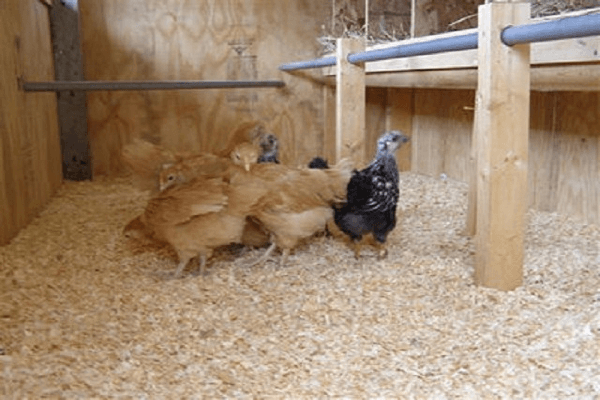
Classification of litter on the floor
House litter can be changed daily or periodically. It differs in the depth of the deck and in the materials used.
By depth
The litter is thin and deep. The thickness of the flooring depends on the season and the frequency of replacement.
The thin coating consists of a small amount of material. The thickness of the flooring is 12-21 centimeters. A thin layer of straw or sawdust is spread over the floor in summer and removed every week.
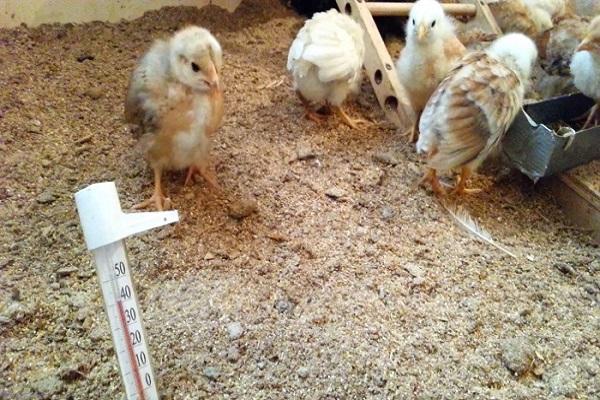
Deep bedding is more suitable for the winter months. The layer thickness ranges from 30 to 50 centimeters. This coating allows you to insulate the floor in the house. First, a layer of 32 centimeters is poured. When it gets dirty, it is not removed, but fresh dry material is simply poured on top.
In the lower layer, biochemical processes will take place: the waste of the vital activity of birds will decompose, heat will be released. Deep bedding is not removed from autumn to spring. However, anaerobic bacteria can become active in it, as a result of which decay processes begin. Birds can develop serious diseases.
A biological product with bifidobacteria will help to prevent negative consequences. This agent stops the decay processes and turns the droppings into compost.
By materials used
You can DIY organic bedding. Straw, sand, hay, peat or sawdust are used as floor coverings for the poultry house. These materials are excellent at absorbing moisture, and they cost a penny.

Bacterial chicken coop litter
In the autumn, before the onset of cold weather, a thick layer of hay or sawdust can be laid in the house and treated with a preparation consisting of beneficial microorganisms. The bacteria will process the droppings into compost. As a result of this reaction, heat will be generated.
The fermentation bedding will ensure the decomposition of the waste products of chickens, the release of heat and the heating of the surface to + 26 ... + 35 degrees, and the additives that make up the bacterial preparation neutralize unpleasant odors.
There is a huge number of biological products for the preparation of bacterial litter in a poultry house (BioGerm, Netto-Plast, Bio-Side, Baikal EM1).

Hay and straw
These natural materials are found in any agriculture. Hay and straw are harvested in the summer: cut grass or stalks of cereals are dried in the sun, placed in a stack, covered with foil, and crushed before use. Then spread on the floor as needed.
Hay and straw quickly absorb moisture, neutralize odors, retain heat, and are completely safe for birds.
Dry leaves
Dry leaves fallen from trees can be laid on the floor of the house. However, the foliage can be crushed before use. For a chicken coop, you can use leaves of maple, linden, birch, walnut. The main thing is that they are dry, with no signs of decay or mold.

Dry moss
Moss (sphagnum) absorbs moisture well and neutralizes unpleasant odors. It grows in a swamp, it is not so easy to collect it. You can combine sphagnum with sawdust, that is, use moss more economically.
Peat
This natural material is good at absorbing carbon dioxide and ammonia evaporation. Peat is taken in pure form or mixed with other materials. Peat bedding has antiseptic properties and helps to avoid infectious diseases. Peat should be dry and crushed. In southern latitudes, instead of peat, you can take sand.
Needles
The floor of the chicken coop can be covered with needles. True, sharp needles can injure the delicate skin of chicken legs. It is better to finely chop the needles. It should be remembered that such material contains many biologically active substances and phytoncides. Vapors of essential oils in high concentrations can affect the well-being of birds. It is better to mix needles with other organic materials.

Sawdust
Cheap and affordable material. Sawdust quickly absorbs moisture, retains unpleasant odors, preserves and generates heat even without the use of fermentation substances. In addition, chickens love to dig in such a substrate. Sometimes hungry birds swallow sawdust. Better not to let this happen and feed the chickens their fill.
Selection and manufacturers
The deep bedding for the winter can be populated with beneficial bacteria. You first need to buy a powder or liquid fermentation preparation. The bacteria will initiate a biological reaction during which the bird's waste products will decompose and generate heat.
In winter, the cold floor will become warm even without heating appliances.
Microorganisms inhabited in the organic litter heat it up to 36 degrees Celsius.

The fermentation preparation is scattered or poured over straw, hay, sawdust. The bacteria contained in it neutralize putrefactive microbes, chicken droppings will decompose slowly. Outlets offer a wide variety of bacterial litter products.They contain the same bacteria, and such drugs differ only in price.
List of popular fermentation agents:
- BioGerm. German preparation, brown powder. Used to make bacterial bedding. It neutralizes disgusting odors well. No more than 100 grams of a biological product is taken per 1 square meter.
- Net-Plast. A Chinese biological product consisting of fermented milk and photosynthetic microorganisms. Bacteria colonize the litter, work intensively and actively, generating heat. For 1 square meter, no more than 100 grams of a biological product is taken.
- Bioside. Domestic biological product. The dry powder is scattered over the bedding. Organic matter is processed into compost under the action of bacteria, during this process heat is released. For 1 square meter, take no more than 50 grams of a biological product.
- Baikal EM 1. A domestic biological product for creating a bacterial bedding. This concentrated liquid is used as a fertilizer. However, it contains beneficial bacteria that process the droppings into compost with the release of heat. One glass of Baikal is dissolved in 12 liters of water, then the litter is irrigated with the solution.

The nuances of using a litter with bacteria
The fermentation bed will function if it is started correctly, that is, laid. First of all, the floor in the birdhouse must be thoroughly cleaned and dried. Then cover with hay, sawdust or other organic material.
Layer thickness should be 22-32 centimeters. It is advisable to trample the bedding material. Put some fermentation preparation on top. The powder-sprinkled bedding material can then be lightly sprinkled with water. The liquid should not contain chlorine, otherwise microorganisms will die.
The bacterial activity is checked after a week. If the floor is warm, then the microorganisms are working as they should. From time to time, the bedding material needs to be loosened to provide oxygen to the bacteria.
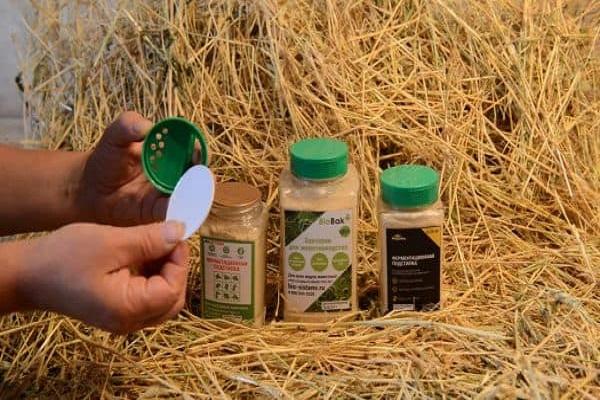
What you need to pay attention to:
- for ventilation - if it is absent in the hen house, the air humidity will increase;
- for flooring - preferably made of stone or tiles;
- on the quality of bedding material - must be organic.
Advantages of keeping chickens on bedding treated with a biological product:
- a lot of heat is generated, the floor is heated;
- pathogens do not develop;
- chickens do not get sick;
- a ready-made compost for fertilization is obtained;
- can lie on the floor for a long time.

How to install and remove bedding
The organic litter is placed on a dry and clean floor with a pitchfork or shovel. Sawdust or hay must completely cover the surface. The layer thickness can be different. In summer - no more than 10-20 centimeters, in winter - more than 30 centimeters.
The top layer of bedding material must be dry. In summer, wet and dirty litter can be raked out. In winter, a little dry material is laid on top of the wet layer, and the flooring is raked out only in spring.
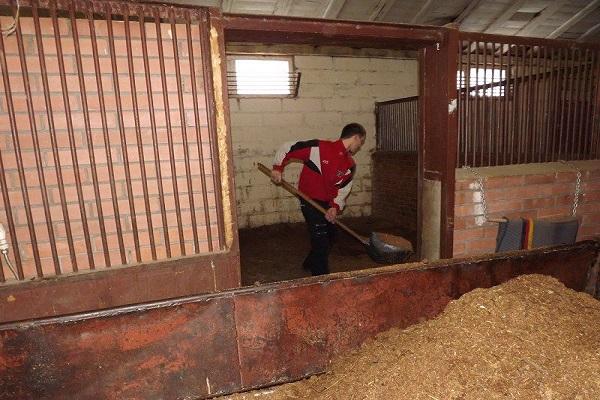
When to start chickens?
The floor in the poultry house is covered with dry straw or sawdust and the chickens are immediately allowed into the house. You can do this event during the day, when the birds are walking in the street.
If the bedding material is treated with a biological product, you need to wait 2-3 days for the bacteria to activate, and then put the chickens into the chicken coop.
